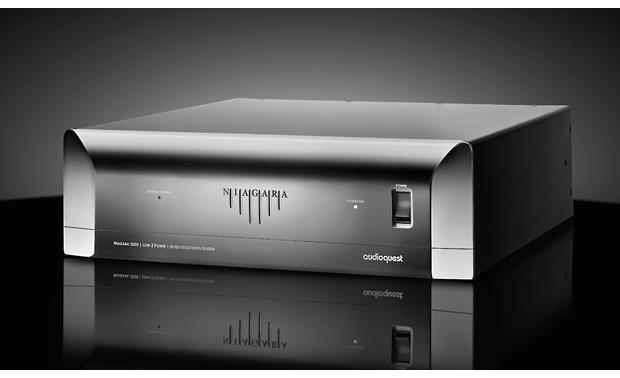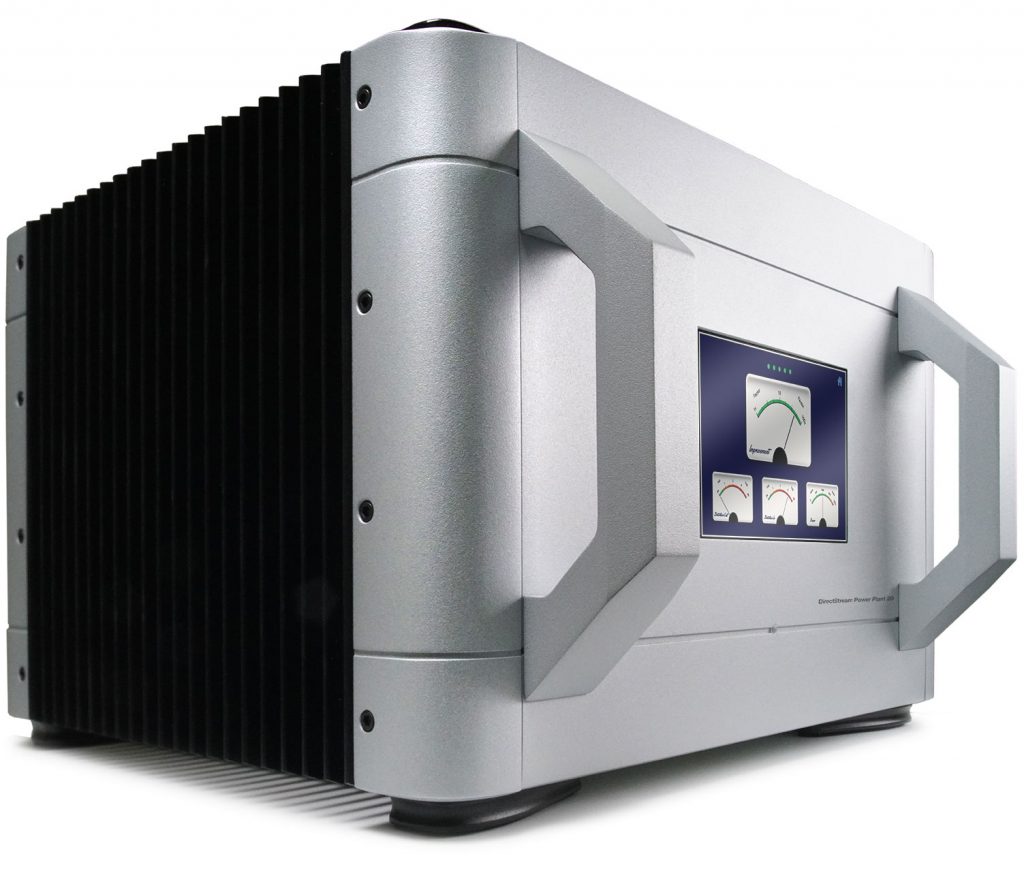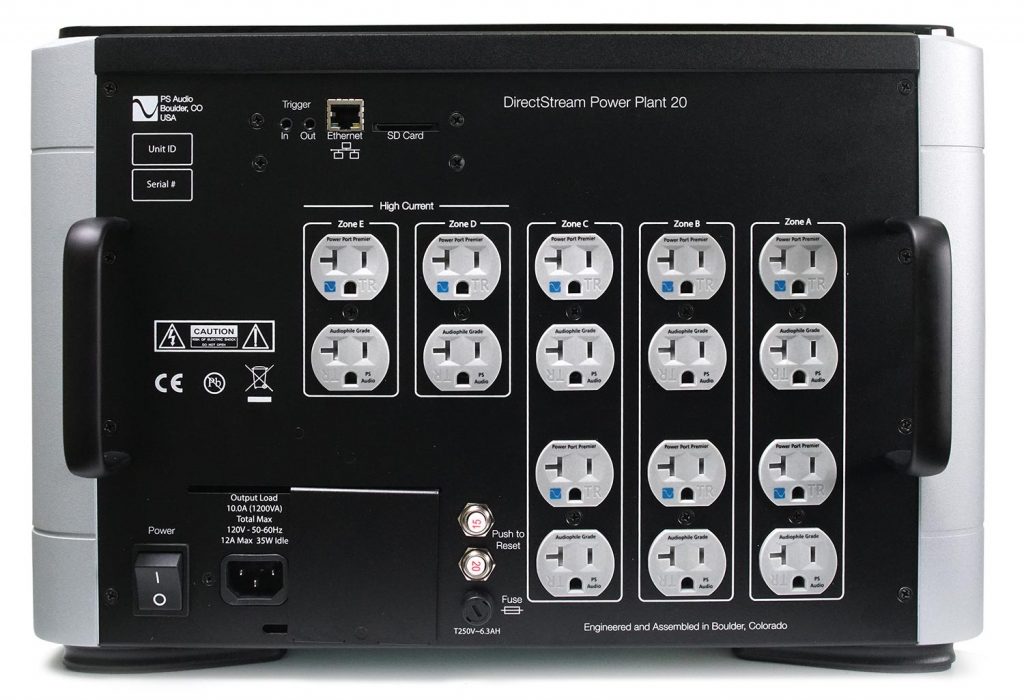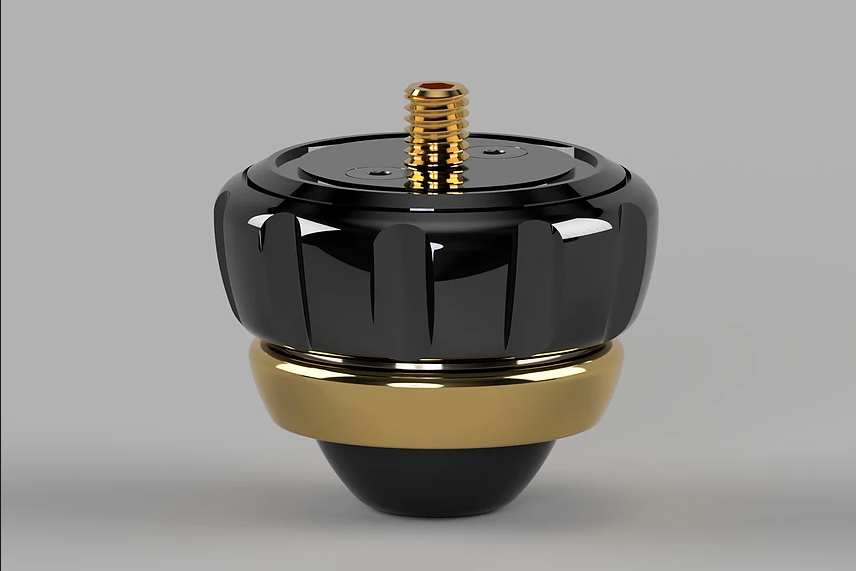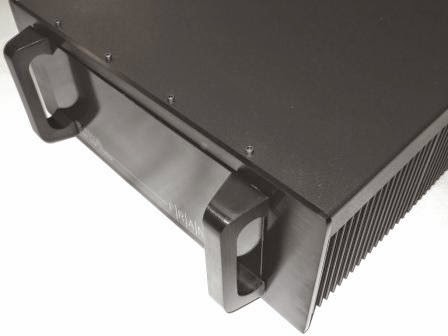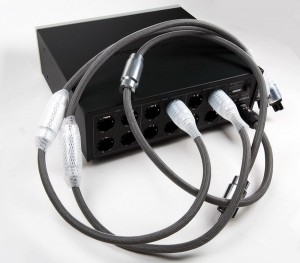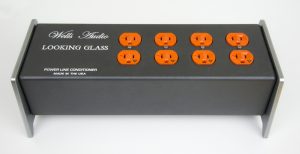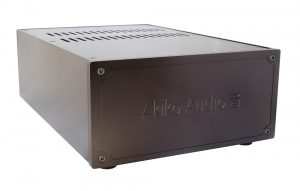Let's face it, AC line power is the bedrock of every audio system. Not only is this singularly common commodity a fundamentally important component, vital for powering all gear in a system, the quality of that AC power line happens to significantly influence the performance capability of every component in each HiFi rig.
The bad news is that the integrity of what is delivered in the home by the AC power outlet is subject to a myriad of influences, all of which are more than likely to be detrimental when it comes to powering audio equipment. Unreliable line voltage stability, noise, distortion, radio frequency contamination, are just some of the most commonly blatant problems.
The good news is that the audio industry has been acutely aware of this AC power line contamination vexation for some time now, and today a new field dedicated to the purification of AC power lines is in full bloom.
We are at a point where AC line conditioners are now considered to be essential audio system components, aiding audiophiles in their unremitting quest of achieving ever better sound reproduction in the home.
Unfortunately, in the real world, evaluating line conditioners is not a cut and dry endeavor. AC power line blight varies all over the map in intensity and complexity, where highly populated areas such as large cities take the brunt. It is there that appliances and equipment that pollute the AC power line are present at disturbingly high levels, and appear randomly distributed.
Given the random nature of this scenario, we must recognize that whatever observations and evaluations take place, any ensuing appraisals should be viewed only with respect to the particular AC line conditions at the review site.
What is desperately needed is to establish a set of standards and definitive measurements so we can gauge and assess the severity of the AC power pollution issue. For example, when we look at amplifier performance we consider distortion levels. And in the digital realm, jitter levels are of paramount importance.
Standardization would go a long way towards clearing up the uncertainty in the hit or miss setting we have now. More importantly, it would greatly simplify the process of choosing the most effective AC power conditioner for each situation.
It's not that the conditioning products are lacking effectiveness, it's just that that the befouled conditions for which they are potentially needed are not clearly identified.
The pessimist in me, however, doubts that anything this practical and unified will come to pass, being that a large part of the audio industry is diseased by NIH -- Not Invented Here.
Nevertheless, my hope is that in the near future someone will at least come up with a practical device that will allow us to appraise the AC power line state of contamination, greatly simplifying choosing and implementing appropriate AC line purifying equipment.
End of sermon.
Discussion
At this point let me touch on a particular concept, something very germane when line conditioners are discussed: there is no such thing as "new" information. While we all are in search of that elusive "more," let us be fully aware that it is simply impossible to improve on the quality of the input signal after it has entered a system. Everything that happens along the way can only degrade the purity of that initial intelligence. The trick is to keep the integrity of the signal to be as close as possible to its original unaltered state during its journey through the system component chain.
For that reason we must think in terms of less compromised or unmasked information.
When a reference is made to "discovering" a bigger soundstage, or more dynamics, or better intonation, all that is taking place is that we are hearing more of the information contained in the input signal, because the interference that was compromising the purity of that signal has been virtually eliminated.
And this is what the core concept of a line conditioner is all about. They are devices that deliver cleaned up power by deterging the AC power line. Powered by this purified energy, the audio system components have the freedom to perform to their inherent high performance capability.
But there is more. The line conditioner happens to occupy a unique position in the hierarchy of the overall system makeup when we consider what each individual component contributes to keeping the signal pure. While components in a system appear in a series arrangement, a line conditioner acts in a global manner since it affects every system component that is powered by it. It is this all-inclusive influence that puts the line conditioner in a singularly significant position.
This rosy situation has a caveat, however. Since the audio world contains a wide variety of devices, it is unrealistic to expect that every available system component will benefit from purified AC power. It could be that some designers include their own means of dealing with contaminated AC power. There are also products that are inherently not as sensitive to the supplied AC power purity.
To purify the AC power line, there are two prevailing approaches used in the industry.
Approach one uses filters to clean up the AC line contaminants. Some designs use series filters, others use parallel filters, and still others use a combination of both. In addition, careful grounding techniques, along with RFI and EMI containment play significant roles. This route does not predominantly rely on active components.
Approach two completely regenerates the AC power by creating a completely new AC power source designed to be independent of what is supplied by the AC power outlet, crap and all. This approach always involves active components.
As expected, each path taken has advantages as well as disadvantages, and involve different levels of sophistication.
The Specifics
Originally I had intended to evaluate only the PS Audio P20. I was coming along very nicely, having settled in and enjoying the benefits of the P20. Just as I was getting ready to summarize my impressions, I hesitated.
I recalled referring to the two fundamental approaches for managing AC line trash that recur consistently in the AC line conditioner industry: Regeneration and Filtering. It occurred to me that the evaluation would be more interesting, as well as more balanced, if a "filter" type AC line conditioner was included. I already had the P20, which to my knowledge, is the most sophisticated AC power regeneration product on the market. Obviously, a perfect representative of the regeneration approach.
After some deliberation I decided that AudioQuest would be an interesting company to consider. All along, AudioQuest has been very well known for cable products, but lately there has been significant buzz in the audiophile press regarding their expansion into AC line conditioning goods and AC power cables. When I approached Stephen Mejias at AudioQuest with my idea of comparing two units, he agreed. Stephen suggested that I review their Niagara 5000 model and use it with the Hurricane power cord for best results. A couple weeks later, the Niagara 5000 and a Hurricane AC power cable arrived for evaluation.
I now had two vastly differing technical approaches in my HiFi stable.
The Niagara 5000 contains few active components, and relies fundamentally on resistors, capacitors, and inductors to achieve their desired goals. They do also implement several very innovative noise reduction and ground current management technologies that they have researched in-house under the leadership of one Garth Powell. Garth came to AudioQuest some years ago, bringing with him 20 years of experience handling AC power line contamination problems.
The P20, on the other hand, employs just about every possible electronic component imaginable. In addition to the basic passive components, the P20 puts to use transformers and transistors. On top of all that, digital technology is also a part of this design.
I found it fascinating that these two companies, having chosen two absolutely different paths to reach the same basic design goal, relied on thinking that was, in each case, innovative to such an extent that respective patents were actually granted for both of these approaches.
The AudioQuest Niagara 5000 Low Z Power/Noise Dissipation System
The Niagara 5000 Low Z Power/Noise Dissipation System consists of three interdependent major subsystems carefully crafted to effectively maximize their combined potency.
First, there is the patented AC Ground Noise-Dissipation System (Patent # 8,988,168). Six discrete circuits isolate, drain, and absorb through loss networks, the RF, computer, and appliance induced noises that mask audio and video signals. This is a critical consideration since the AC ground is directly connected to component circuit ground.
Second, there is the Ultra-Linear Noise-Dissipation Technology, an ultra-wide bandwidth linearized AC filter, both differential and common-mode. It acts to reduce AC line noise and related disturbances over an exceptionally wide bandwidth of 21 octaves, insuring that the frequencies in the audio band can be reproduced as unscathed as possible, and through circuit linearization, as consistently as possible. According to AudioQuest, it is the widest bandwidth in the industry.
Third, working in tandem with that sub-system, is the passive / active Transient Power Correction Circuit. This is a current reservoir that acts as a buffer for current hungry components with dynamic-draw power supplies such as power amplifiers. AudioQuest explains: "Our correction circuit bolsters and stabilizes the power supply of any power amplifier by providing a buffer and an instant current reservoir of up to 80+ amps peak (up to 25mS)."
The bottom line is that these three features, AC Ground Noise-Dissipation System, Transient Power Correction Circuit, Ultra-Linear Noise-Dissipation Technology perform correlatively to deliver an AC power supply that will allow the components that depend on this purified power to attain performance levels of their true design potential. The rather subdued outward physical presence of the Niagara 5000 does not provide any indication of the innovative sophistication that is contained in this relatively modest parcel. The 5000 comes in a metal case that is 17.5" wide by 5.24" high by 17.3" deep. The 38 lbs weight of the 5000 is a welcome heft for me - I can handle it with relative ease. The front panel, with its darkened mirror like finish, is sure to leave an elegant impression. There are no elaborate displays except for two indicator LEDs labeled "Power On" and "Extreme Voltage," and a rocker switch for the power ON / OFF function. That's it. No bells, no whistles.
It's the rear panel where the 5000 gets down to very serious business. Here we find a total of 12 grounded AC power outlets. They are arranged horizontally in 6 groups of duplex outlets that are labeled Bank 1 through Bank 6.
Bank 1 and Bank 2 carry the designation "High Current/Low-Z Power Correction." These two AC outlet banks have been specifically designed to accommodate high current demanding components, such as power amplifiers and powered subs or powered speakers. Banks 3 through 6 are labeled "Ultra-Linear Noise-Dissipation System." Utilizing loss networks, these 8 discrete circuits isolate, drain, and absorb the RF induced noise that veil precious audio subtleties.
Furthermore, this group of 8 isolated AC power outlet banks has 16 amp RMS average (@220-240VAC 50/60Hz) current capacity. "These outlets utilize high spring-strength beryllium copper base metal with heavy, thick silver-plated contacts. This assures far lower loss and distortion, while providing a superior means of draining radio frequency noise." Also on the rear panel is an IEC-C20 AC power inlet connector. AudioQuest provides the beefier 20 Amp type since the larger contact pins offer a much more substantial contact area resulting in a very efficient mode of connection in addition to providing a very firm mechanical engagement.
Last but not least is a rocker switch, also on the rear panel, that selects a "Standby" or "Engaged" function. In the "Engaged" position the "Transient Power Correction Circuit as well as the "Ultra-Linear Noise-Dissipation Circuits" are fully activated. This switch has to be in the "Engaged" position in order to get the Niagara 5000 to perform to its full fledged capability.
In summary AudioQuest points out: "Every conceivable detail has been addressed: in the Niagara 5000 you'll find optimized radio-frequency lead directionality, capacitor run-in forming technologies developed by Jet Propulsion Laboratories and NASA, and AC inlet and outlet contacts with heavy silver plating over extreme-purity copper, assuring the tightest grip possible."
The price for the Niagara 5000 is $3999.95. AudioQuest supplied the Niagara 5000 with a 3 m long Hurricane AC power cord which lists at $2849.95.
The PS Audio Direct Stream Power Plant P20
PS Audio chose to go the regeneration route in their attempt to provide a refined AC power source. They certainly are not new to this approach, having initiated the regeneration approach a couple decades ago, and have been steadily refining their products over time. Today they offer a number of sophisticated AC line conditioning products using the power regeneration approach. The PS Audio Direct Stream Power Plant P20 is their flagship offering and is the most powerful and sophisticated of their power regeneration designs.
PS Audio has very strong opinions regarding their regeneration approach. They appear not be too keen when "filter" types of line conditioners are concerned: "Power conditioners are passive collections of capacitors, resistors, transformers, and coils of wire which lack the ability to add missing energy back onto the power line. Power Plants use active components, like those found in large and powerful audio amplifiers, to store and release energy for peak demands (up to 70 amps), rebuild the AC signal and produce clean, clear, distortion-free, regulated AC for your equipment. When performance matters, why compromise?"
PS Audio is obviously very proud of what they have accomplished and boldly declare: "The P20 will improve system performance like nothing else".
At first glance AC power regeneration is fundamentally straight forward. Start with a precision source of a 60Hz signal and feed it into a very powerful amplifier and, voila, at the output we have an unwavering 60 Hz power source. Sure sounds simple enough. But why is it then that the PS Audio P20 weighs in at 96 lbs and is priced at a dollar short of $10,000? Why is then that PS Audio was granted a patent (Patent Number 7259705) for the innovative technology used in the P20?
It turns out that what may be simple to conceptualize is not necessarily easy to execute. When something as heavy as 96 lbs (actually 105 lbs when shipped) shows up at my doorstep it is sure to catch my attention. Measuring 17 inches wide by 14 inches deep by 11 inches high it is a beast for sure, making it the heaviest audio electronic component that I have ever used in my system.
At first glance, especially seeing the generous heat sinks on the sides, the outward bearing of the P20 gives off a vibe of a really robust power amplifier. Well, that's because that is what it really is for the most part. The P20 is rated to supply 1500 VA with a 15 Amp AC power line input and 2000 VA with a 20 Amp supply. When pushed to the maximum the P20 will do as much as a whopping 3600 VA. We are talking very serious power here that requires a very serious power amplifier to accomplish that.
To provide all that power the P20 relies on an internal power amplifier run in Class AB. That potent amplifier consists of a hefty toroidal power transformer, a substantially sized filter capacitor stack, and a very robust output power distribution structure utilizing potent copper bars for handling the high current levels. No wiring is used for distributing the high output current levels. Instead they implement "aerospace grade pure-copper, ¼" thick gold-plated buss bars handling all current paths."
PS Audio is emphatic about what they have accomplished: "Power Plants use active components, like those found in large and powerful audio amplifiers, to store and release energy for peak demands (up to 70 amps), rebuild the AC signal, and produce clean, clear, distortion-free, regulated AC for your equipment." On top of all that performance capability, the P20 provides overvoltage protection that will prevent any input spikes from reaching the equipment that is powered by the P20.
This PS Audio P20 Power Plant is one of the most aesthetically appealing components to come along. I found its overall execution to be very elegant and efficiently accomplished. In my further explorations, I came to appreciate that the hefty P20 incorporates a number of finessed features with particular attention to user convenience. It is said that familiarity breeds contempt. In my encounters with the P20 that was certainly not the case.
For example, when I carefully delved into the user manual, I came away full of appreciation and admiration: not only is this sucker very sophisticated, it sure is user friendly in spades. That impression was further underscored when the front panel of the P20 was examined. Yes, two very robust handles are provided there as expected. But the big surprise was the large interactive touch-screen that took up a significant area of the front panel. Using this interactive touch screen, the user has the option to selectively examine the performance of the P20 in real time by simply using the touch screen or the remote control.
One such informative choice brings up a view of 4 individual meters that display "The Improvement Factor," "Distortion Out," "Distortion In," and "Power," a composite indication of the performance of the P20. The Improvement Factor is an average of the Voltage and the Total Harmonic Distortion at the output of the P20 and expresses how well it has improved the AC power it supplies. The Power meter shows the total power in watts that the P20 is supplying to its load. The Input and Output distortion readings are self explanatory.
The P20 instrumentation goes one step further and includes an oscilloscope screen. With this visual aid the user can choose to inspect the incoming 60Hz waveform that appears at the input of the P20. Or elect to audit the newly regenerated 60 Hz output waveshape of the P20. Or observe the differential between the input and output waveforms. All with a touch on the screen or a click on the remote.
I found that difference signal to be the most telling. Here was an all-in-one visual summary of how successfully the P20 was doing its intended function of providing a powerful regenerated 60 Hz output waveform. The larger this signal, the better the job of cleaning up is taking place. However, in the spirit of keeping it real, I have to mention that I found the inclusion of the oscilloscope to be of very little use. It may be of a real deal when marketing bells and whistles, I'm sure. This scope, especially in the size provided, is of little use other than observing gross deviations from the sine wave of the input power supply. It is not capable of displaying any problems due to say RFI or something as subtle, but potentially impactful.
I found the Status Panel to be far more informative concisely delivering practical information. Here you have Voltage In/Out, THD in/Out, Power Out, Current Out, and frequency. What more do you need? That out of the way, there is, however, the very innovative side of the P20. I had mentioned earlier that a 60Hz signal is needed as the reference that is fed into a power amplifier to configure a power regeneration unit. PS Audio determined that it is not just any ol' 60 Hz signal that will do the job with proper effectiveness. Here's their choice: "The P20's FPGA based DSD engine delivers the cleanest, lowest noise sine waves of any regenerator in the world." In other words, a DAC.
I asked Darren Myers, a PS Audio engineer, why a DAC? Here is his response:
"There are two main advantages of using a DAC over an analog oscillator. A digital based oscillator allows the ability to change the reference signal beyond a simple linear modification, such as frequency and amplitude. An example is in our MultiWave feature: we add a third harmonic to increase the width at the top of the waveform. This increases the connected components diode conduction time and charges capacitors faster—similar to increasing the amount of capacitance in the power supply. If we are introducing a 3rd harmonic, what's the point of the regenerator? Even in MultiWave, the output impedance is dramatically lower than a wall outlet. This improves voltage regulation and essentially eliminates voltage sag that robs power amplifiers of their dynamics. Second, the 3rd harmonic is introduced in a way that ensures only the fundamental and the 3rd are present. This eliminates the real harmonic distortion issue that you have coming out of your wall—it contains toxic high ordered distortion harmonics that cause components to have an elevated noise floor or a 'grayish' background."
That explanation of MultiWave is about as complete as we will ever get. The magnitude of Multi Wave feature is re-settable by touching the general Setup screen on the front panel or with the remote control.
In a like manner it is possible to activate the CleanWave feature. PS Audio explains: "CleanWave injects a series of higher frequencies that ride on the main sine wave to help 'degauss' connected magnetics." The user can choose to initiate the CleanWave process for a duration of 5 seconds or 60 seconds with the click of a button on the remote. A small rectangular blue display, found in the upper left corner on the front panel, indicates the ON/OFF state of the P20.
But the "let's get down to business" aspect of the P20 is found on the rear panel. Or as the User Manual points out: "The P20 has a lot of outlets."
How right they are! Here PS Audio provides a total of 16 IEC grounded outlets for powering the system equipment to be energized by the P20. These 16 outlets appear in 5 groups labeled Zone 1 through Zone 5.
Zones 1 through 3 consist of 4 outlets each while Zones 4 and 5 are labeled "High Current" and contain two outlets each. This denotes that these outlets have been designed to handle the extra current surges that powerful devices such as power amplifiers or powered subwoofers demand.
The P20 can be programmed to have each Zone of the power outlets respond to a variety of power on or power delay sequencing. The user can select to have all outlets to be controlled by the main ON/OFF switch, or have any Zone be delayed, or have the delay programmed to enable a custom delay, or have the outputs of a chosen Zone perform a "Reboot" function. The main ON/OFF switch is located on the back panel. Nearby are two sets of IEC AC line inlets intended to accept either a 15 Amp power cord or a 20 Amp power cord. A sliding cover obscures the unused receptacle. Also on the rear panel is an RJ-45 jack to facilitate an Internet connection and two small jacks for trigger signal inputs and a slot for an SD card.
A remote control is provided for turning the P20 ON/OFF, to dim the main display and navigate through the "MultiWave" and the "CleanWave" functions mentioned earlier.
I have to admit that initially I found the numerous options very intimidating. It turns out that to use the P20 there is no need to utilize any of its inherent versatility. It aligns completely with the KISS philosophy: Keep It Simple Stupid! It performed with complete functionality with only the default settings in place. Obviously, the options are there to squeeze out the last bit of performance from the P20. I took the P20 out of the box, put it in place and fired it up. It worked like a charm!
But then the engineer in me got the best of me and I could not resist playing with all the instrumentation features. Besides having a ball exploring all the bells and whistles, I developed a great respect for what PS Audio has achieved by the P20 along the lines of flexibility and monitoring.
For example, I adjusted the output voltage of the P20 to be the same as the input voltage, a reading of 124.5 volts, that that is the norm at all the outlets in my house. This way, the same voltage will be supplied to the equipment being powered regardless of the power source, be it the wall outlet, the Niagara 5000, or the P20.
In my setup I did not hear any performance changes when I adjusted the MultiWave function. Just to be safe, I left it in the maximum position. I treated the Phase Tuning in a similar manner and selected Auto Tune.
I had much better success with the CleanWave. When I called for the CleanWave to perform for the 60 second interval, there was a slight sense of ease and better flow of music during the subsequent playback. Not enough though, for me to initiate this cleansing function more than occasionally.
I have to mention that the P20 comes with a very user friendly packaging system. Basically, after lifting off the top cover, the container of the P20 unfolds the four sides so that they lie flat on the floor. This allows the P20 to be slid off the unfolded container into its intended placement position. Hint: Before doing any sliding DO NOT remove the plastic bag used to protect the P20. Since the plastic bag offers very little friction it will ease the repositioning of the P20. Remove the plastic bag only after the P20 has been placed in its final resting place.
Full disclosure
Besides the review P20, PS Audio also provided me with each of their premier pieces of audio equipment on a short term loan basis.
It all started shortly after receiving the P20, when my trusty Devialet D-Premier decided to malfunction and it had to be returned to Devialet for repairs. I have had the D-Premier since February of 2011 and was sold early on of Devialet's innovative power amplifier technology soon after I had read the Paul Miller review in Hi-Fi News. I purchased it from Audio Plus Services in Canada well before Devialet decided to start distribution of their products in the USA. The D-Premier had never been out for repairs in all this time.
Of course, I contacted Bill Leebens at PS Audio to let him know that because of this development there will be a delay in the review process. Bill's response to my dilemma was to make me an offer that I could not refuse. He proposed that PS Audio would send me the BHK Preamplifier, the DS Player, the DS DAC, and a pair of the BHK 300 watt monoblocks to "tide me over" while the D-Premier was being repaired. Of course, I accepted.
This was not a case of audiophile greed. I realized that these PS Audio components would provide an additional load to better put the P20 and the Niagara 5000 through their paces. The two BHK 300 watt monoblocks alone were desirable for that purpose, but the preamp, DAC and player would make up a load far more diversified than the combination of my resident music servers, the Schiit Audio Gungnir DAC and the Devialet D-Premier pieces could.
Equipment and Setup
After the D-Premier came back ready to roar, I proceeded to set up two complete systems.
System 1 would consist of the PS Audio components and System 2 would be what I use normally. Both systems powered the Revel Salon2 loudspeakers. Connections for system 1 were made using Cardas Clear audio interconnect cables and used Cardas Audio Clear Beyond for the speaker cables. All power cables were exactly the pieces that were normally supplied with each of the PS Audio components.
System 2 consists of my regular components. A Laufer Teknik MP64 Memory Player, designed by Mark Porzilli, or an Aurender N10 music Server fed the Schiit Audio Gungnir DAC driving the D-Premier Integrated amplifier with a pair of Purist Audio Design Dominus Rev B interconnects and Cardas Audio XLR to RCA adapters. An AJ Conti designed, Basis Audio Signal Science Labs Cables speaker cable fed the speakers
The AC power cord for the D-Premier is a Furutec NANO FP-559 which allowed the D-Premier to perform to a significantly higher level than with a run-of-the-mill AC power cord. The icing on the cake—it fits exceptionally well into the tight space at AC inlet of the D-Premier.
AC power for my system is provided by a dedicated 70 foot run of AWG 8 copper cabling directly from the main circuit distribution panel and terminated in a quad of hospital grade duplex outlets.
All AC power line internal terminations for the duplex outlets, as well as the screws of the dedicated circuit breakers for each line, have been treated with silver contact paste from AI Technology, Inc.
My room is 17' wide, 8' tall and 30' long. Unfortunately, the dimensions are not proportioned very ideally, but I did the best I could with speaker placement and room treatment.
The speakers are set up to play into the 17' dimension. For room treatment I have a set of 12 Acoustica Applicata DaaDs of various sizes and two pairs of Shakti Hallographs. Along the walls and ceiling I have installed 15 Synergistic Research High Frequency Transducers (HFTs) in the prescribed locations. The equipment is supported by a combination of two Star Sound Technologies Sistrum platforms and 3 Symposium Ultra platforms from Symposium Acoustics. I have found that their Precision Couplers work to good sonic effectiveness when supporting electronic gear. The Laufer Teknik MP64 Memory player and the Aurender N10 music server were the sources for all of the music used for all the listening evaluations.
Except where indicated, the Niagara 5000 was always used with the Hurricane AC power cord with its 20 Amp connector.
For the P20 I chose to use the 20 Amp inlet for all my listening. The 20 Amp connector provides pins with more surface area and therefore can provide a more effective connection and can handle higher current flow when necessary. The AC power cord for the P20 is a generic, off the shelf unit with a 20 Amp connector at the P20 end and a standard AC plug at the end for the AC outlet.
The Hurricane AC power cable and the AC power cable for the P20 were connected to the run of the mill duplex AC wall outlet to keep the setting to closely resemble a generic home situation.
The testing procedure was very basic. I plugged all the AC cords of the particular system components I wanted to use for the evaluation into the AWG 8 run duplex outlets. After listening and taking notes. I proceeded to move those power cords to the Niagara 5000 or the PS Audio P20.
I have to confess that this project ended up more complicated than I initially anticipated. Now that two line conditioners were involved, in addition to the two complete systems, the number of permutations for the various test scenarios grew to a very complex level. I have never moved more AC power plugs from one piece of equipment to the other and, obviously, not just once.
Cautions
In my experience over the years, setting up and running-in equipment are two areas that always demand special attention. I suspect that the marketing people had a hand in writing the user manuals because the information there tries to make it appear that everything is very simple and easy in the two areas I mentioned. My experience differed. I did not find that the Niagara 5000 sounded good right out of the box as the user manual suggests: "...the Niagara 5000 will perform very well from the first moment you use it." The initial impression was one of disappointment, where the sound of the system was made quite shrill and peaky. Completely unlike the sound that resulted when the Niagara 5000 settled in.
The other bone I have to pick is the issue of how to support the equipment. Over many years of dealing with this concern, I have found that the manner in which equipment is supported can have a significant effect on the overall sonic performance of that piece. I used cones or Ayre Myrtlewood Blocks or other similar means to good effect for both units. More about that later.
AudioQuest does discuss that best performance can be expected when the Niagara 5000 is placed so that the standard feet do all the supporting. That worked out well. But they also state that the unit can be used on its side. While the gist of their suggestion is more related to safety issues, in my experience the performance the Niagara 5000 was compromised if it was not placed with its standard feet on a very sturdy, and I mean sturdy, support structure or shelf.
Much to my surprise, I do not recall PS Audio mentioning anything about a run-in period nor means of supporting the P20.
The Results
As an engineer I have a reasonably good theoretical understanding how the nasties of the AC power line end up cramping the performance of the electronic components of our audio systems. What took me by surprise, however, was how potently these two AC line conditioners performed their magic. The affirmative performance measures that were brought to light by both of these two products were far from subtle. Hearing their wizardry for the first time was quite impressive and gratifying as well. It was a revelation, something more than what I had anticipated.
For example, I discovered that the impact of any cable substitutions or swaps of power amplifiers paled when compared to the positive and clearly perceived performance gains that emerged when the AC power conditioners were in use.
As a result, a wealth of musically pertinent information flourished with unencumbered freedom unfolding as a significantly enriched sonic sensibility. I heard a pleasing clarity and refinement in addition to a more assured grip on dynamics. The surges of power energized the sonic setting yet provided a comforting effect during the calamitous sections. All this materialized against a deeply black, eerily hushed background. It became obvious that the system components in use were now performing at levels that handily exceeded those that I had experienced before the implementation of the line conditioners.
My point is, that having made no changes with any of the individual system pieces, the performance of the system as a whole blossomed unmistakably when either conditioner was included.
The Revel Salon2s projected a new level of sonic proficiency. Since they were not changed in any way, the Salon2s were now merely responding successfully to a signal of a significantly better refinement level.
As mentioned earlier, the reason for this leap in improvement is due to the consideration that the line conditioner influences the performance effectiveness of every component that is powered by it. This is a communal scene where every piece of gear in the system benefits from the cleaned up AC power. Regardless of what I played, the music was now more exciting, more enjoyable and more involving. More exciting because there was more to be heard harmonically and spatially. More enjoyable because the identities of the instruments emerged as more accomplished. More involving because the unobscured and consequently better developed sonic images had a closer resemblance to an actual live musical event. There was a sense that every note was in place. That every overtone was properly proportioned. That each decay was allowed to dissipate in a determined manner.
And veils appeared lifted. In some instances to a remarkable degree. More space and air materialized freed from the pall of AC line interference. As a result, sonic imagery blossomed yielding better focus and pronounced dimensionality. In this unencumbered setting the music flourished in a natural manner leading to a more intimate engagement with the performance.
As thrilling as it is to be introduced to fresh nuances and timbral gradations in familiar recordings, it is more engaging when this wealth of revealed information emerges as an increase in musical fit, effortlessly leading to a new measure of musical involvement. Detail for the sake of detail can lead to an analytical presentation. The AC line conditioners appeared to help the system components that they powered to present the newly unrestricted minutiae in a manner that allowed the recorded instruments to be heard with greater authenticity. This was an atmosphere of comfort, a sensibility of ease and merit for the whole musical event.
The Specifics
At this point it bears repeating that the AC power line quality is not a clearly defined deal. Just like there are no two listening rooms that are alike, it is just as unlikely that there are two AC power lines that have the same contamination constitution. Add to that uncertainty the situations where the AC power line conditions are near ideal, the inclusion of a line conditioner is not likely to bring about any sonic benefits.
PS Audio is well aware of this uncertain reality and offer a 30 day money back trial period for their power regenerators. They have also addressed the situation where not every case needs a powerful solution like the P20 and offer lower power regeneration models for systems that demand less power. But I digress. I just want to remind everybody that the conclusions I discuss are based on the conditions that exist for my particular AC power line into my house.
I also want to point out that, generally, the review units were used and evaluated as supplied by the respective manufacturers. The AudioQuest Niagara 5000 went through the paces paired with the Hurricane AC power cord while the PS Audio P20 was used with a generic 20 Amp AC power cable. The best way I can describe the performance traits of each of the conditioners is by viewing them in terms of real life personalities.
For me the PS Audio P20 presented itself as a solid, dignified, and confident individual. It behaved like a mature, cultured personality who could be relied upon to habitually impart candid truth with a slight hint of majesty. In this setting, for me, the musical presentation the P20 was the beneficiary of a very welcome sense of a firm foundation. The bass region was very rigid with an abundant reach down to an even sturdier lower territory. Being that its weight is just shy of 100 lbs, I suspect that its performance benefited from this very unyielding mechanical infrastructure. The midrange conveyed a convincing certainty that projected a sense of compelling intentness. This aura of immediacy often translated into sonic scenarios where I was often drawn into a performance spellbound and engaged. And full of admiration. For me, this aptitude to completely capture my attention is the strong point of the P20. The upper reaches were always free flowing, extended and airy and delivered with an urgency that excelled in dynamic expressiveness.
The AudioQuest Niagara 5000 in combination with the Hurricane AC power cord, on the other hand, exhibited more of an outgoing personality and displayed a tad more flamboyance. For example, it allowed the dynamics to be a bit more authoritative, with transients taking on an urgency that more closely resembled the nimble fleetness of musical instruments in a live, unamplified musical setting. The subtleties of harmonic complexities were unraveled to be more vivid. This allowed the musical instruments to emerge with a palpably pronounced purpose that more closely characterized their inherent individuality. With newfound freedom, they sprung to life with compelling verve significantly enhancing the sense that the sentiment of the musical presentation was now more complete. It was this more complete that endeared me to the AudioQuest Niagara 5000 energized by the Hurricane AC power cord. In time, I found that the listening sessions with the AudioQuest components tended to be more extended often leading me to listen to complete works all the way through. This certainly was not some hastily reached response.
When I started out listening to both units, I have to admit that I was quite taken by the novelty of interacting with line conditioners and experiencing newfound performance levels. At this early stage of the review process my preference was for the unit that was in play at the moment. But as time went on and I became more familiar with each of these pieces, I noticed that I was spending more time with the Niagara 5000. Despite some concerted back-and-forth between the two units, the pull still tended towards the Niagara 5000. For me, it had that more lively and spontaneous quality described earlier.
Of course, I could not leave things to remain in such a rudimentary state. To be fair, I had to explore other pertinent component combinations. It was unimaginable that every sale of a Niagara 5000 would include a $2849.95 Hurricane power cord. For me it was more likely that a P20 buyer, having shelled out ten grand, would go for an additional $2849.95 for the Hurricane AC cable. So I exchanged AC power cords. The P20 got the Hurricane, the Niagara 5000 the generic 20 Amp cable.
Wow! The P20 suddenly got a clear jump in its performance capability. The bottom octave grip increased. The music was now more incisive, more transparent, with an added measure of dynamic heft. The "ability to completely capture my attention" mentioned earlier had now risen to a new level of appreciation.
Next I placed 3 Avalon Acoustics 36mm Apex steel cones under the P20 to change the support mechanism. Another Wow! There was a clear-cut upsurge in the sonic integrity. Plus an increase in immediacy and tone color. Embroidered with an effervescence of inner detail, the soundspace materialized into an aura of spaciousness. As a result, the dimensionality of the soundstage increased to a new level, unveiling a more arresting performer placement. The high end now had a liberated ease giving the music a free and effortless air. Very impressive. And more captivativating yet. This was an exceptional performance accomplishment for sure.
With the P20 back on solid ground, because that is how it will most likely be used in most cases, I then went to powering it and the Niagara 5000 conditioners with the plain 20 Amp cords. Pretty darn good results for both, but that last gush of energy and level of vividness was curtailed. However, there were performance gains there that, I'm sure, would set many a system aglow even with this level of unmasked intelligence. Yet even here the Niagara 5000 still displayed that zest and a touch more of that jump factor that had me gravitate to it in the beginning.
Almost There
To summarize, I found that the combination that resulted to provide top performance during this extensive exercise, consisted of the PS Audio P20, supported by the Avalon Acoustics 36mm Apex steel cones, and powered by the AudioQuest Hurricane AC power cord. Hardly surprising. This level of achievement was the result of a judicious tweaking in combination with top grade associated components.
Next in line is the merger of the AudioQuest Niagara 5000 with the Hurricane AC power cord. Here too the Niagara 5000 was supported by an imposing means of physical support. This very stern and solid support consisted of a four piece high stack of 16" by 16" patio tiles separated by a ½" thick absorbent pads. Over time I discovered that there was a significant jump in synergy between the Niagara 5000 and the Hurricane AC power cord. Surprised? Of course, not. Both of these pieces were designed by the same AudioQuest team.
Next in line was a tie between the Niagara 5000 with a stock 20 Amp AC power cord and the PS Audio P20 with a stock 20 amp AC power cord connected to the 20 Amp AC input of the P20. I could not get over the very engaging ability of the P20 to handle midrange material where I would be drawn into the performance convincingly. Additionally, the P20 had an impressive stability in the lower reaches of the spectrum that added firmness and established authority to the performance.
The Niagara 5000, on the other hand, had this feeling of sonic exuberance and vitality on top of a very solid foundational bearing.
These rankings came after many hours of listening with many changes in equipment, supports, and AC cords. I found that the AudioQuest Hurricane AC power cord played a significant role in changing the realm of performance.
Many thanks to PS Audio for making all their top end equipment available, in addition to the P20, for this review. It allowed me to experience for myself just how accomplished each of these pieces actually is. It was a learning adventure through and through. Having all this sophisticated equipment available greatly helped to make these evaluations more credible. I can also point out that I did not experience any distinct advantage of using the P20 or the Niagara 5000 when powering the PS Audio amplifiers or the rest of their wonderful gear. Each power purifier acted in the manner as described.
In the real world we are talking some serious money issues here. The P20 goes for $9999.00, the Niagara 5000 for $3999.95, and the AudioQuest Hurricane 3 meter AC power cord for $2849.95.
The Conclusion
After all is said and done, it is obvious that these two AC line purification appliances are excellent products. After all, all roads lead to Rome. I am recommending each of the units wholeheartedly.
When the PS Audio P20 was supported carefully and powered with the Hurricane AC power cord it produced extraordinary results.
The Niagara 5000, on the other hand, in combination with the Hurricane AC power cord, did check off a lot of boxes on the positive side of the ledger for me and ended up engaging me in a manner that differed from what the P20 did.
I am sure that my preference for properly reproduced detail and speed played a role in my conclusions.
In this vast exercise I performed a head-to-head comparison under the conditions that exist at my humble abode. It is not far fetched to imagine that in another location—remember no two AC power sources are likely to be the same contamination wise—things might have settled differently. More significantly, the same tests with different system components might yield different impressions yet.
Until definitive standards and measurements to assess the level of AC power line drivel come along, we remain in this cut and try subjective world of ours.
PS Audio
AudioQuest




